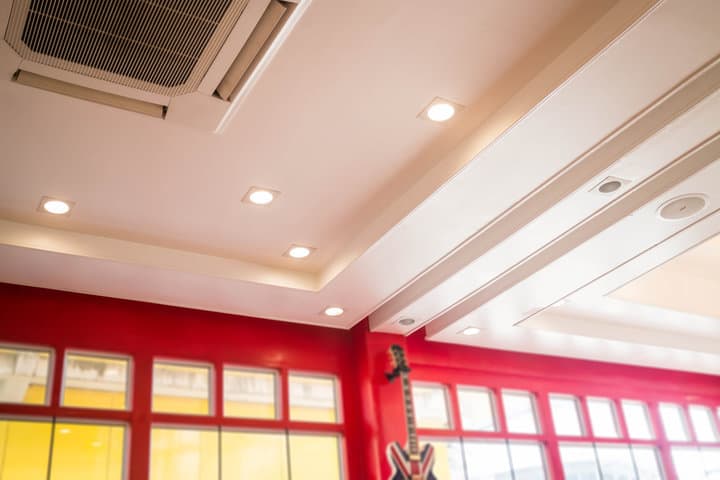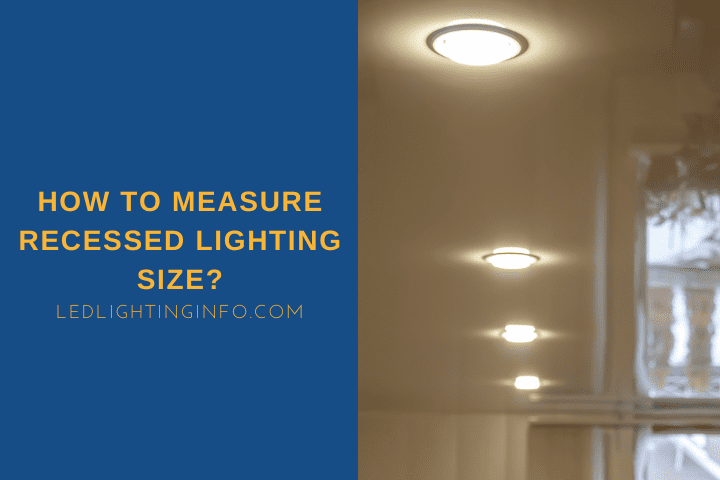Nobody likes the idea of cutting holes into a pristine ceiling. Moreover, it’s a little intimidating since repairing the ceiling if it goes wrong is not exactly an easy task.
This is why you must measure your recessed lighting correctly when installing a new one.
Cut holes that are too small, and your lights won’t fit. You’ll likely make a mess as you try to cut those small holes bigger.
And cut holes that are too big? The lights won’t fit in place, they’ll just fall through, and you’ll have a big repair job on your hand.
So how do you measure?
Measuring recessed lighting can be done by drawing around the can or the top part of the light fixture for canless lighting. Most recessed lights come with a guide you can draw around to make it easier. Don’t cut the hole for the visible lip – it should only be big enough for the part of the light that goes into the ceiling.
Let’s take a bit more of a detailed look at:
- How to measure the size of the hole you need
- Common recessed light sizes
- How to measure the distance from the wall
How Do I Measure The Size Of Recessed Light Ceiling Hole?

When measuring recessed lighting, you are either measuring an existing light or a size you need to cut for a new light.
For canless lighting, these are the same.
Canless recessed lights don’t have any extra housing, so the dimension of the hole is the width of the part of the light that will be clipped into place in the ceiling.
But can lights have the can housing, which lives inside the hole once it’s cut. And so the actual hole is slightly bigger than the can itself.
Can lights are sold in standard measurements that are usually a rounded figure in inches – 4″ and 6″ are common.
But that’s the hole size once the housing has been inserted.
So if you want to measure an existing light, just remove the trim and measure the distance across the housing from the widest point.
But, if you’re measuring out a circle to cut for a new hole, you need to cut one slightly bigger.
Otherwise, the housing won’t fit.
The size of the hole you need to cut will be included in the instructions for the light, or you can see them below.
You may also be provided a guide circle to draw around on the ceiling to know what you need to cut.
Common Dimensions Of Recessed Light

The most common size of recessed light you can buy is 6 inches.
To be clear, that’s the housing size – the trim will be slightly bigger and vary depending on the design (some have a slightly thicker trim than others.
4″ is another typical size used, but there are others too.
For canned lighting, you also need to consider the height of the can.
They tend to come in standard or shallow sizes – the standard is more commonly used (hence the name), but if the joists are not too tall, then shallow can be used instead.
Here’s a guide to the common sizes of canned lights and the size of the holes you would need to cut to fit them:
| Light type | Housing diameter | Hole diameter | Standard can height | Shallow can height |
|---|---|---|---|---|
| 4-inch | 4 inches | 4 ⅜ inches | 5 ½ inches tall | 3 ½ inches tall |
| 5-inch | 5 inches | 5 ⅝ inches | 7 ½ inches tall | 5 ½ inches tall |
| 6-inch | 6 inches | 6 ⅜ inches | 7 ½ inches tall | 5 ½ inches tall |
You can sometimes find smaller lights, like 2-inch or 3-inch lights, but these tend to be used for special functions such as cabinet lighting rather than main room lighting.
Canless lights are slightly different and easier to remember – if you’re cutting a new hole for the lights, you should aim to cut them the same size as the light itself.
Standard sizes remain 4 inches and 6 inches, so you should cut a 4-inch or a 6-inch hole.
Having said that, because the lights clamp into place, you can replace a 6-inch can light with a 6-inch canless light, even though the hole would be an extra three-eighths wider than recommended.
Related: How To Convert Incandescent Recessed Light?
How Far Should I Put Recessed Lights From The Wall?

You can use many different formulas to calculate the distance between your lights.
It depends on how many lights you want to use in your room and how brightly you want it to be lit.
Remember that some rooms where you are carrying out tasks, such as a kitchen, need brighter lights than a room where you’ll just be relaxing.
Once you’ve calculated the number of lights you are planning to install, try to stick to these two rules:
- You want the lights nearest the wall to be between 1.5 feet (18 inches) and 3 feet (36 inches) from the wall
- The space between lights should be double the space between the edge lights and the wall
So, say you have a room measuring 10 feet across – 120 inches. And you plan on adding three lights in a row.
To work out the spacing, think of it as six individual spacings. The first is between the wall and the light. Then you have a double space between light 1 and light 2.
Then another double space between lights 2 and 3. And then a single space to the other wall.
So now you know it’s 6′ spacings’, divide the room’s length by 6. 120 inches divided by 6 is 20 inches.
This works – 20 inches is between the recommended 18-30 inch gap from the wall. So space your lights 20 inches from the wall, with a 40-inch gap between them.
If you were planning on adding four lights in a row, you would need to have 8 spaces (single spaces at each end and 3 lots of double spaces).
120 inches divided by 8 is 15 inches, so that would also work.
Your measurements would be 15 inches between the wall and the light and 30 inches between each light.
This is why it’s essential to always plan first – it’s here where you’ll work out if you’re adding too much lighting and need to scale it back.
Also read: How To Convert Recessed Lights To Pendant?
Final Words
Planning and measuring your recessed lights is such an important step.
It’ll help you to understand where to place your lights and make sure you cut holes that are the right size.
Fail to prepare; you don’t just prepare to fail – you’re preparing to butcher your beautiful ceiling.
Have you had any lighting installation disasters? Or maybe you’ve got some handy tips on getting the right size of light for the room?
Looking for an LED bulb but not sure what type you need?
Check out my free bulb picker and select the right bulb within few clicks.

